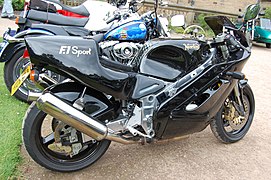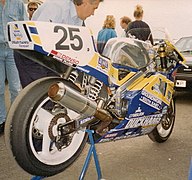Yamaha Motor Co., Ltd. is a Japanese mobility manufacturer that produces motorcycles, motorboats, outboard motors, and other motorized products. The company was established in the year 1955 upon separation from Nippon Gakki Co., Ltd. and is headquartered in Iwata, Shizuoka, Japan. The company conducts development, production and marketing operations through 109 consolidated subsidiaries as of 2012.

The Norton Motorcycle Company is a brand of motorcycles headquartered in Solihull, West Midlands,, England. For some years around 1990, the rights to use the name on motorcycles was owned by North American financiers.
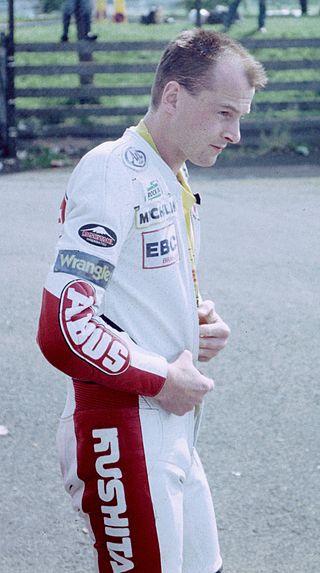
Robert Steven Hislop was a Scottish motorcycle racer. Hislop won at the Isle of Man TT eleven times, was the British 250cc Champion (1990) and lifted the British Superbike championship on two occasions.

Chris Walker is a British motorcycle road racer and former scrambler with the nickname The Stalker. He is a four-time runner-up in the British Superbike Championship, and a former race winner in the Superbike World Championship. For the 2015 season Walker signed for Tommy Hill's Be Wiser Kawasaki Team aboard a Kawasaki ZX-10R in the British Superbike Championship, following his 2014 season with Lloyds British GBmoto squad. Team manager Hill left in August, 2015, and the team folded in September, leaving Walker without a ride for the final two race meetings of the season.

The BSA Gold Star is a motorcycle made by BSA from 1938 to 1963. They were 350 cc and 500 cc single-cylinder four-stroke production motorcycles known for being among the fastest bikes of the 1950s. Being hand built and with many optional performance modifications available, each motorcycle came from the factory with documented dynamometer test results, allowing the new owner to see the horsepower (bhp) produced.

Stephen Robert Dunlop was a Northern Irish motorcycle racer, the younger brother of fellow road racer, the late Joey Dunlop, and the father of William Dunlop and Michael Dunlop. Like Joey, Robert died after a crash. His son William died in a crash during practice at the Skerries 100 in Dublin on 7 July 2018.
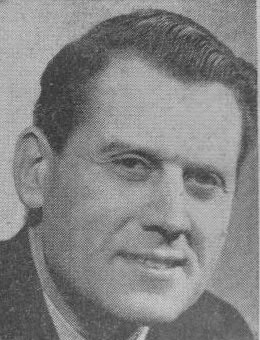
Douglas Lionel Hele was a pioneering British motorcycle engineer with Triumph and other firms: BSA, Douglas and Norton. He was born in Birmingham in 1919 and died in Hagley, Worcestershire on 2 November 2001.
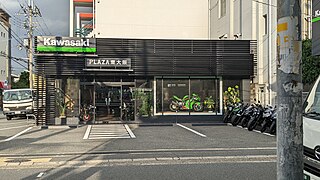
Kawasaki Motors, Ltd. is a Japanese mobility manufacturer that produces motorcycles, all-terrain vehicles, utility vehicles, watercraft, outboard motors, and other electric products. It derives its origins from Kawasaki Aircraft Industries, a subsidiary of Kawasaki Heavy Industries, and is rooted in the motorcycle, boat, and engine businesses. In 1953, they began manufacturing engines for motorcycles and have since produced products such as the Mach and Ninja series in motorcycles and the Jet Ski, which has become a generic term for personal watercraft. Until 2021, it was a division of Kawasaki Heavy Industries, known as the Kawasaki Aerospace Company (川策重工業汎用機カンパニー) and later the Kawasaki Motorcycle & Engine Company (川崎重工業モーターサイクル&エンジンカンパニー). In 2021, it was separated as Kawasaki Motors, Ltd, a wholly owned subsidiary of Kawasaki Heavy Industries.

The Norton Classic is a rotary-engined motorcycle built in 1987 by Norton as a special edition of just 100 machines.

The Norton F1 is a road-going sports motorcycle that Norton based on its RCW588 racing motorcycle. The F1 was offered in only one livery: black with gold decals and grey and gold stripes, to reflect John Player's sponsorship of Norton's race team. It was distinctive for using a 588 cc liquid-cooled twin-rotor Wankel engine. This unit was developed from the motor in the Norton Commander.

BMW S1000RR is a race oriented sport bike initially made by BMW Motorrad to compete in the 2009 Superbike World Championship, that is now in commercial production. It was introduced in Munich in April 2008, and is powered by a 999 cc (61.0 cu in) four-cylinder engine redlined at 14,200 rpm.
Ian Simpson is a retired motorcycle road racer from Scotland, nicknamed the "Dalbeattie Destroyer".

The featherbed frame was a motorcycle frame invented by the McCandless brothers and offered to the British Norton motorcycle company to improve the performance of their racing motorcycles in 1950. It was considered revolutionary at the time, and the best handling frame that a racer could have. Later adopted for Norton production motorcycles, it was also widely used by builders of custom hybrids such as the Triton, becoming legendary and remaining influential to this day.
David W. Garside is an inventor and former project engineer at BSA's Umberslade Hall research facility. He is notable for having developed an air-cooled twin-rotor Wankel motorcycle engine which powered the Norton Classic road bike. Although the Classic was not the first production rotary-engined bike, it was significantly lighter, smoother, more powerful and better-handling than the contemporary Suzuki RE5.
Jim Moodie born 15 February 1966 in Dumfries is a former British Superbike, Supersport and Isle of Man TT racer who retired in 2003 from the TT races after being involved in the accident that claimed the life of David Jefferies. He also raced successfully in British Superbikes, finishing second on two occasions and winning the Supersport championship twice, the first time with his own private bike.
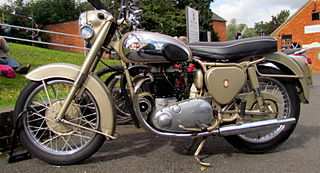
The BSA A10 series was a range of 646 cc (39.4 cu in) air-cooled parallel twin motorcycles designed by Bert Hopwood and produced by Birmingham Small Arms Company at Small Heath, Birmingham from 1950 to 1963. The series was succeeded by the A65 unit construction models.

Bridgestone motorcycles were a division of the Bridgestone Tire Co. of Kyōbashi, Tokyo, Japan that produced mopeds and motorcycles from 1952 to 1970. Initially producing power assisted bicycles, the division moved on to producing mopeds and then motorcycles. The motorcycles were technologically advanced and powered by two-stroke engines. The high technical specification resulted in the machines being more expensive compared to other manufacturers models. Production was stopped in 1970 to protect the supply of tyres to other manufacturers.
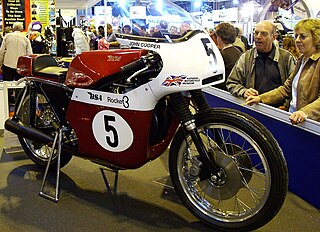
The BSA/Triumph racing triples were three cylinder 750 cc racing motorcycles manufactured by BSA/Triumph and raced with factory support from 1969-1974. There were road racing, production racing, endurance racing and flat track variants. The machines were based on the road-going BSA Rocket 3/Triumph Trident.

The Norton Commando Production Racer was a hand built production racer produced by Norton-Villiers from 1970 - 1972. It was based on the road-going Norton Commando, and although fitted with lights it was never intended as a road bike. The model was commonly known as the Yellow Peril.

The John Player Norton, also referred to as JPN and JPS Norton, were a series of Formula 750 racers manufactured by Norton Motorcycle Company from 1972 to 1974 and sponsored by cigarette manufacturer John Player. The engine for these machines was derived from the unit used in the Norton Commando, which was a development of the 1948 Bert Hopwood designed 500 cc Dominator. The lack of power from the engine, compared with other manufacturers, led designer and rider Peter Williams to a adopt a radical approach to chassis design. Riders of the bikes included Williams, Phil Read, Tony Rutter, Mick Grant, John Cooper, Dave Aldana and Dave Croxford.



